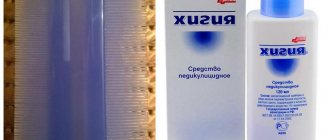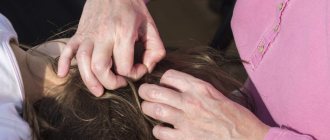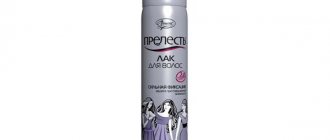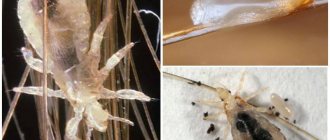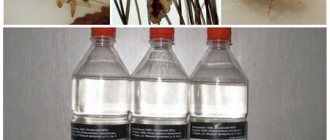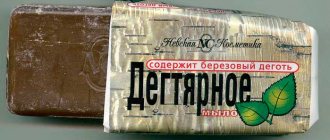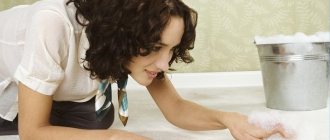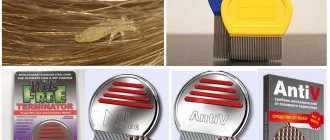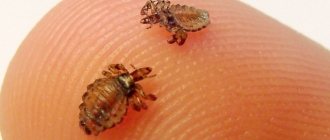When is it carried out?
All activities when identifying pediculosis are carried out in strict accordance with the law within certain deadlines:
- in preschool educational institutions and boarding schools, employees and students are checked monthly;
- The school organizes the event once a quarter;
- Checking and processing for detection of head lice in the emergency department is carried out upon admission to the hospital, and then weekly.
According to the new SanPiN, when lice and nits are detected in a group of people with whom the patient has been in contact, an examination is carried out outside the plan, and preventive measures are taken.
Nurse's tactics when identifying pediculosis
Algorithm for studying the scalp
Checking for head lice can be carried out in a hospital emergency department, paramedic station or clinic. The sequence of examination is recorded in a special document - “Protocol for the management of patients.”
Inspection algorithm:
- Unbraiding and combing the patient's hair.
- Examination of the patient's hair using a comb and a magnifying glass. The check begins from the temples and back of the head.
- Inspection of underwear for possible detection of body lice.
- Examination of the intimate areas of the body (armpits and pubis) for the possible detection of lice pubis in the patient.
Inpatient examinations must be carried out wearing medical gloves, which are discarded after the examination. Also, after the procedure, the comb and comb must be disinfected with medical alcohol.
What documents need to be completed?
There are certain actions a nurse can take after detecting parasites in a patient’s scalp, which primarily involve filling out documentation:
- Registration of a log of identified cases. Sometimes, when pediculosis is detected, it is necessary to fill out the “Infectious Diseases Log”. In them, the nurse must indicate the type of pediculosis (head, body, pubic) and its stage (presence of eggs or lice).
- Filling out a special table about the detection of pediculosis.
- Recording a case of identified pediculosis in the patient’s medical record.
- Report the identified case to the department of the State Sanitary and Epidemiological Surveillance.
Only after this can the nurse proceed to sanitary treatment of the person infected with lice.
Nurse's actions
In the reception department, special papers are filled out, and the patient’s head, body, and personal belongings are examined. If live lice and nits are detected, the nurse conducts a thorough examination and determines the degree of infestation.
When pediculosis is detected, it is necessary to fill out a special journal table. The nurse’s tactics are aimed at destroying parasites, notifying relatives, and obtaining the patient’s consent to disinfestation measures. If this is a child of preschool or school age, the heads of the educational institution are notified.
After identifying head lice, filling out all the necessary documents, and obtaining the patient’s consent, he is transferred to a separate room where sanitization will be carried out.
The procedure is contraindicated:
- children under 3 years old;
- pregnant, lactating;
- patients in serious condition;
- in the presence of ulcers, wounds on the head.
In other cases, the nurse is obliged to carry out disinsection before admitting the patient for inpatient treatment.
Treating items against parasites
Pediculosis in health care facilities is eliminated in a comprehensive manner - the patient’s head and personal belongings are treated. After destroying the parasites, they burn the paper where the dead insects and nits were located. Things and linen are put in plastic bags and sent to a special chamber for disinfestation. The same should be done with the gown of the nurse who did the treatment.
The comb is thoroughly lubricated with alcohol. Rubber gloves are burned. Disinsection of the premises is carried out. In the examination log, the nurse records the procedure. Schedules a re-examination of the patient in 7 days.
Treatment of a patient when pediculosis is detected: how to do it correctly
Lice are small insects from the category of obligate ectoparasites. The oral cavity of these insects is designed in such a way that they can pierce human skin and suck blood from it. In addition, louse can serve as a carrier of diseases such as typhoid.
At a time when there are still very few of them in the hair, it is very difficult to notice parasites. In such cases, discovery usually occurs by chance, during hospitalization or examination. It is for this reason that they are most often detected much later, when an impressive population has formed in the hair.
In such cases, it is considered mandatory to carry out appropriate procedures.
Who is subject to mandatory verification?
Since lice infestation is a type of contact infection, timely detection of the source is necessary to prevent further spread. According to the order of SanPiN, checking for head lice is of the following types:
- Scheduled, which is performed with a certain frequency.
- Unscheduled, the duration of which is not set in advance. It is performed if a person infected with lice or nits is found in a group.
The following categories of people are checked:
- patients undergoing inpatient treatment - once every 7 days, as well as upon admission;
- children and adult staff of kindergartens, homes and boarding schools - monthly;
- in schools, inspections are carried out once a quarter (after the end of each vacation);
- in social security institutions - 2 times a month;
- other categories of workers - when undergoing routine medical examinations.
A therapist, family doctor, nurse, dermatologist or paramedic at a rural medical center can check a person’s condition.
Such a check can be carried out at least every day, especially if there is a suspicion of the possibility of infection or there has been contact with similar patients.
The test is very simple and consists of examining hair and clothing under a bright light and preferably using a magnifying glass. It is difficult to do this on your own, so it is better to hire an assistant.
The easiest way to detect nits is because they are firmly attached to the base of the hair. Lice hide in the hair and may not be detected, especially if the hair is very thick and dark.
To work, cover the surface with white paper or cloth, comb the hair with a fine-toothed comb and check what may fall out of it. It would be a good idea to check all hair-covered parts of the body, as well as the seams of clothes and underwear.
Nurse's actions
In the reception department, special papers are filled out, and the patient’s head, body, and personal belongings are examined. If live lice and nits are detected, the nurse conducts a thorough examination and determines the degree of infestation.
When pediculosis is detected, it is necessary to fill out a special journal table. The nurse’s tactics are aimed at destroying parasites, notifying relatives, and obtaining the patient’s consent to disinfestation measures. If this is a child of preschool or school age, the heads of the educational institution are notified.
After identifying head lice, filling out all the necessary documents, and obtaining the patient’s consent, he is transferred to a separate room where sanitization will be carried out.
The procedure is contraindicated:
- children under 3 years old;
- pregnant, lactating;
- patients in serious condition;
- in the presence of ulcers, wounds on the head.
In other cases, the nurse is obliged to carry out disinsection before admitting the patient for inpatient treatment.
Treating items against parasites
Pediculosis in health care facilities is eliminated in a comprehensive manner - the patient’s head and personal belongings are treated. After destroying the parasites, they burn the paper where the dead insects and nits were located. Things and linen are put in plastic bags and sent to a special chamber for disinfestation. The same should be done with the gown of the nurse who did the treatment.
The comb is thoroughly lubricated with alcohol. Rubber gloves are burned. Disinsection of the premises is carried out. In the examination log, the nurse records the procedure. Schedules a re-examination of the patient in 7 days.
Causes, symptoms and incubation period of the disease
You can become infected with lice through contact with a sick person. Most often, this phenomenon occurs in public places, for example, in schools and kindergartens, or in baths and saunas.
The main cause of this disease is considered to be poor personal hygiene.
If a healthy person uses a comb, hair clips, or hats of a patient, then the likelihood of contracting lice is very high.
Experts have discovered rather unusual factors that contribute to the development of this disease. For example, head lice show great interest in people who are regularly under severe stress and often worry. During such periods, the blood begins to pulsate intensely, so the sweat glands become more active, which attracts blood-sucking parasites.
Symptoms of pediculosis:
- presence of severe itching;
- formation of ulcers at the site of scratching of the skin;
- presence of rash, boils;
- peeling of the scalp;
- increased greasiness of the hair due to the secretion secreted by lice.
One female louse lays from 3 to 7 eggs per day.
When examining the skin, you can find head lice that are gray in color. They are located at the roots of the hair. Today there is a fairly effective way to recognize nits. For this, special electric combs and Wood's lamps are used, which make it possible to detect larvae without much difficulty.
Once symptoms appear, you must immediately begin treatment for head lice. If pediculosis is detected, the incubation period of lice is up to 3 weeks if there are nits on the scalp. The process of development of a nit to an adult takes 21 days.
Body louse develops within 2 weeks if the clothing temperature is at least 25°, but if it is more than 30°, then the incubation period lasts 7-10 days. The pubic louse overcomes the period of 5-10 days.
However, nits do not hatch if the temperature is below 22°.
The most common places where nits accumulate are the temples, neck, back of the head and the area around the ears. Pubic lice spread in the bikini area, on the eyebrows and eyelashes, causing discomfort in a person.
The incubation period of pediculosis when the scalp is infected can last up to 1 month, after which the patient exhibits the first symptoms of the disease, most often characterized by itching.
The head louse infects a healthy person through any contact with a sick person. In most cases, transmission of the parasite occurs through contact of hair or clothing. More rarely, infection occurs through clothing and personal hygiene items: towels, combs, brushes, bed linen. This is due to the location of insect colonies on the scalp, especially in the back of the head and temples.
If parasites multiply quickly, the hair begins to stick together from purulent exudate and serous fluid. The latter emerge from ulcers that appear in place of lice vinegar. Some individuals can settle on eyelashes and eyebrows, on the skin behind the ears, and neck.
When infected with head lice, the following clinical picture is observed:
- There are nits (eggs), nymphs and adult lice on the scalp and hair;
- during a bite, parasites inject a special enzyme into the wound, which prevents blood from clotting and causes an allergic reaction;
- parasitic infestation is accompanied by severe itching;
- irritation of the skin occurs, the appearance of hematomas, blood crusts, and the development of ulcers;
- during scratching, wounds can fester, which leads to the appearance of pyoderma and regional lymphadenitis;
- A papular rash, erythema, and roseola appear at the bite sites;
- With a long course of pediculosis, the development of dermatitis, peeling and hardening of the skin is observed.
If these signs appear, you must contact a medical facility to prevent or treat head lice. A therapist, infectious disease specialist, dermatologist, or paramedic can confirm the diagnosis. The child must be taken to the pediatrician.
Mandatory examination is carried out in the following patients:
- orphans or children left without the care of guardians or biological parents;
- living in boarding schools, orphanages;
- students in an educational institution: schools, kindergartens, colleges;
- people visiting health centers, sanatoriums or boarding houses;
- prisoners in prisons or pre-trial detention centers;
- patients undergoing inpatient therapy, hospitalized patients;
- medical staff.
If head lice is detected, the person is isolated until complete recovery. The patient is regularly sanitized with preparations to destroy all lice and nits.
Source: https://TezarVape.ru/ektoparazity/obrabotka-pri-obnaruzhenii-pedikuleza.html
Methods used
Modern anti-pediculosis treatment of the patient includes the following methods:
- Mechanical. They involve removing parasites and their eggs by washing, combing or cutting the hair. Previously, hair removal was one of the most common ways to combat lice. Nowadays, mechanical methods are most often used where it is impossible to use “heavy artillery” - chemicals and insecticides. They are used if a child, a pregnant woman, a severe allergy sufferer is infected with lice, as well as in the presence of extensive or deep skin lesions. Hair removal and combing are combined with washing with a vinegar solution, which removes the “glue” and helps get rid of nits.
- Physical. They mainly involve heat, which is aimed at removing parasites on personal belongings. This includes boiling, ironing with a very hot iron, steaming at high temperatures, and also heating the hair with a hairdryer (used with restrictions).
- Chemical. These are the main ways to get rid of lice, since with the help of drugs you can radically remove insects and avoid relapses.
We suggest you familiarize yourself with: Treatment of fur coats against moths
The most effective technique is a combination of all three methods of influence.
Disinsection procedure
Hair treatment for pediculosis
The nurse's actions for pediculosis include determining the degree of infection and selecting an effective product. Initially, it is necessary to carry out preparatory activities:
- the couch and chair where hair treatment for pediculosis will take place is covered with oilcloth;
- a robe is put on the patient or a sheet is thrown over it, a tourniquet from a scarf is tied along the hairline;
- the health worker puts on a gown and rubber gloves to avoid getting sick;
- prepares everything you need - shampoo, head lice remedy, comb, vinegar, basin.
The treatment algorithm for pediculosis involves removing head lice and combing out nits. Additionally, personal belongings are disinfested. The room should be well ventilated. You must proceed as follows:
- Prepare the solution in the required quantity according to the instructions.
- The hair is divided into strands and each is processed separately. Try not to get it on the scalp.
- Long hair is wrapped in a bun.
- Put a plastic bag over your hair or a special cap.
- Be sure to wait according to the instructions.
- Wash off the composition.
- Prepare a solution with the addition of vinegar, rinse your hair, put on the plastic cap again, and leave for 15 minutes.
- Wash your hair again and dry it lightly with a towel.
The further scheme for treating the patient involves a combing procedure. Preparation consists of choosing a suitable place, having a comb, and medical alcohol.
- The patient is seated in a well-lit place.
- Lay out white sheets of paper.
- Remove dead lice and nits with a special comb with frequent, long teeth. Periodically clean with a cotton pad soaked in an alcohol solution.
The final result directly depends on the thoroughness of combing out nits. After the procedure is completed, an examination is performed again. It is recommended to treat hair against lice again after 14 days. This is done either in a hospital facility, if the patient is staying in hospital for a long time, or at home. You also need to fill in the result of reprocessing.
Necessary tools and equipment
The following materials and accessories are required for processing:
- two sets for medical personnel, including a gown, gloves, and scarves;
- a cape or cape for the patient, a polyethylene and cotton scarf;
- hair clipper, scissors;
- Shaver;
- a comb with frequently spaced teeth for combing out lice and nits;
- pelvis;
- bags - cotton and plastic;
- shampoo, soap;
- table vinegar;
- anti-pediculosis agent.
Detection of lice
Upon admission to hospital treatment, a preliminary examination is carried out to detect lice. This happens at the sanitary inspection station in the clinic. Examinations for head lice in the department are carried out by medical staff. The nurse should use a magnifying glass or a special comb to examine the occipital and temporal parts of the head.
Lice detection
Each recorded case is recorded in a journal, and a corresponding note is made on the patient’s card. Depending on the patient’s condition, a treatment plan is developed and first aid is provided.
If head lice are detected in a patient, the medical worker notifies the patient’s relatives, and also notifies a preschool or educational institution if lice have been detected in a child. In this case, an unscheduled examination is carried out in classes and groups, which must be organized by the medical staff of the institution.
We suggest you read: How to treat an apartment against fleas
The patient signs a document in which he gives his consent to undergo treatment in the inpatient department. Depending on the financial condition of the clinic, the presence or absence of an insurance certificate from the patient, lice medications are taken either from the institution’s fund or purchased independently.
The procedure is performed in a well-ventilated, isolated room. The nurse explains to the patient all the nuances of the upcoming event and prepares the necessary equipment:
- scissors;
- container for hair disinfection;
- latex gloves;
- oilcloth drape;
- plastic cap;
- fine pitch comb;
- pediculicide;
- packages;
- cotton swabs;
- vinegar 9%;
- alcohol.
Anti-pediculosis treatment
The treatment algorithm is as follows:
- The patient is seated on the couch. A knitted tourniquet is tied around the scalp. An oilcloth cape is put on the shoulders.
- The person carrying out the treatment puts on an additional robe, scarf, and rubber gloves.
- Apply the antiparasitic solution evenly to the strands, avoiding contact with the face and mucous membranes. Rub the product into the scalp with light massage movements.
- Put a cap or scarf on the patient.
- Exposure lasts from 20 to 40 minutes, depending on the product used and the recommendations specified in the instructions.
- Rinse your hair with warm water.
- Rinse with vinegar solution.
- Lay down light-colored paper and comb out dead insects and nits.
- Check for any remaining lice.
Upon completion of the procedure, the patient’s underwear and clothes are packed into a bag. A robe and scarf are placed in the second bag. Packed items are sent to a disinfection chamber. The paper on which the lice were combed out is burned. Disinfection work is carried out in the premises. If the patient’s condition allows, he is subjected to hygienic procedures.
A repeat examination for pediculosis is carried out after 7 days. If necessary, the procedure should be repeated. If the patient is discharged earlier than the specified period, further examinations are carried out in the clinic. Beforehand, the patient is given recommendations for the prevention of head lice, which will help prevent the appearance of lice in the future.
The frequency of examination of the patient is determined by the type of head lice and the degree of infestation, but at least once every ten days.
Initial sanitary treatment of the patient when pediculosis is detected consists of several stages. It is performed in a well-ventilated and lit room.
The processing method is related to the type of lice:
- For pilar lice, medical personnel dressed in a gown, scarf and gloves examine the patient's scalp. If detected, the employee puts on another set of protective clothing to avoid infection. The seat is covered with film or oilcloth, the patient is seated, covering his shoulders with a cape. Protect the face and neck with a cotton bandage to prevent the insecticide from getting on the skin and mucous membranes. The drug is applied for a quarter of an hour, covered with a film and then a cotton cap. At the end of the exposure period, wash your hair, rinsing with vinegar to destroy nits. Then they comb for a long time (at least a quarter of an hour), achieving complete removal of insects, over the basin, in a separate strand.
- For lice pubis, or phthiriasis, the genital area is most often treated with the drug in an aerosol. To make sure there are no parasites, it is best to remove hair in the groin area, armpits, and chest. After the exposure time has expired (half an hour - an hour), the patient needs to wash with soap in the shower.
- In case of body lice, it is necessary to treat not only the person himself, but also check his clothes and linen - underwear and bedding. The body louse does not live permanently on the body, moving onto it only to feed. It can be found in the seams and folds of items that must be thoroughly cooked, preferably boiled, and then ironed with a hot iron.
We suggest you familiarize yourself with: Insect with claws on its tail
If the actions are carried out correctly, it is possible to destroy all insects, but for reliability, a second inspection is carried out after 10 days. The quarantine lasts a month, only if during this time there is no relapse, the infection is considered defeated.
Sanitary treatment of a patient with pediculosis algorithm
/ Shampoos
Back
: 03.05.2020
Reading time: 14 min
0
1
- 1 Nurse actions
- 2 When is it carried out?
- 3 Disinfestation procedure
- 4 Methods used
- 5 Actions with things
- 6 Necessary tools and equipment
- 7 Effective drugs
- 8 Sanitation algorithm for pediculosis
- 9 Algorithm for treating a patient with pediculosis
- 10 Final stage
- 11 Reprocessing
- 12 Necessary tools and equipment
- 13 How processing is carried out
- 14 Sanitary education is an important element in the prevention of pediculosis
- 15 Algorithm for performing the procedure when identifying pediculosis;
- 16 Application of anti-pediculosis styling
- 17 Main manifestations of the disease
- 18 In what cases is processing carried out?
- 19 ALGORITHM FOR TREATMENT FOR PEDICULOSIS.
- 20 How to get rid of lice and nits at home
Treatment of head lice in a hospital
All activities when identifying pediculosis are carried out in strict accordance with the law within certain deadlines:
- in preschool educational institutions and boarding schools, employees and students are checked monthly;
- The school organizes the event once a quarter;
- Checking and processing for detection of head lice in the emergency department is carried out upon admission to the hospital, and then weekly.
According to the new SanPiN, when lice and nits are detected in a group of people with whom the patient has been in contact, an examination is carried out outside the plan, and preventive measures are taken.
Effective drugs
Detection of head lice is a mandatory procedure before admitting a patient to the ward. If lice are detected, the nurse must carry out treatment. Medicines for lice are provided by a medical institution or purchased by the patient at his own expense.
The nurse can offer the patient several options for remedies. The choice depends on financial capabilities, personal preferences, as well as the presence or absence of individual intolerance to the components.
For the treatment of head lice, patients are prescribed Nittifor, Paranit, Medifox, Nyuda, Para Plus, Nyx. Or they are treated with an emulsion of benzyl benzoate, dicresyl.
Final stage
If head lice is detected, sanitary treatment of the patient is not completed after disinsection of hair and personal belongings. Since lice can easily spread, all the patient's belongings and the nurse's clothes are packed in pre-prepared bags and sent for thermal exposure.
The comb, which was used to comb out lice and nits, is cleaned of insects and immersed in alcohol of at least 70 degrees. All other instruments are treated with vinegar and alcohol, and if possible, doused with boiling water.
Cut and combed hair, parasites, and consumables are carefully collected and disposed of by burning.
The sequence of actions of a nurse when identifying pediculosis
Equipment: robe, waterproof apron, gloves, oilcloth, towel, comb, anti-pediculicide.
I. Preparation for the procedure 1. Put on an additional robe, apron, and gloves. 2. Explain to the patient the need and sequence of the upcoming procedure and obtain consent to perform it. 3. Sit the patient (if condition allows) on a chair covered with oilcloth (or lay oilcloth on the floor and place a chair on it). 4. Give the patient (if possible) a towel to protect his eyes from getting the pediculicide. If the patient is unable to hold a towel, an assistant will do this for him, who should also have an additional gown and gloves. II. Performing the procedure 5. Treat the patient's hair with any anti-pediculicidal agent. 6. Cover the patient’s hair with a cap for 20 minutes (some technologies do not require a cap) 7. Rinse the hair with warm water and dry it. 8. Comb dry hair with a fine-toothed comb for 15-20 minutes, dividing the hair into strands and combing each strand sequentially. III. Completion of the procedure 9. Place the patient’s linen and clothes in bags for disinfestation. 10. Remove gloves, apron, robe (place in a bag for disinfestation), wash your hands. 11. On the title page of the “Inpatient Medical Card”, make a note about the identified pediculosis: “P” (Latin pediculus - louse). 12. Fill out an emergency notification about the detection of an infectious disease and report it to the sanitary and epidemiological inspection institution (form No. 058u), register the patient’s data in the “Register of Infectious Diseases” (form No. 060u). 13. Examine the patient's dry hair.
After disinsection of the patient, the room and objects with which he came into contact must be treated with the same pediculicidal preparations. The comb is doused with boiling water after each inspection, or wiped with a 70-degree alcohol solution.
The technique for treating the pubic area for pediculosis is outlined in the guidelines for the pediculosis remedy.
A repeat examination of the head or pubis is carried out after 10 days.
When clothing lice is detected, clothing and bedding are treated every week. Underwear is boiled and ironed every day for a week.
If a patient is admitted to a medical institution for planned hospitalization, treatment of hair and clothing is carried out at home, or in special pest control centers. Items should also be treated with pediculicides.

